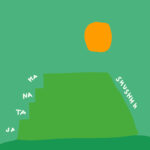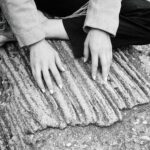The literal translation of chakra is “wheel” or “disk.” This is in reference to energy centers located in our subtle body along the spinal column and flowering to the front of the body. Therefore, these disks of energy are not physical, tangible entities. Rather, they are like feelings or thoughts; something that cannot be touched but do, nevertheless, have a strong effect on the body. The patterns ingrained in our chakras form the core of our being, affecting our physical body, the way we think, the way we interact with the world and how we access our deepest self. They help us become conscious of our karmas, samskāras and vāsanās, to ultimately break the cycle of samsāra (suffering). Karmas are the actions we choose with one of the following results:
Generate good karma.
Use up good karma.
Generate bad karma.
Burn up bad karma.
Based on our habitual actions (karmas), we develop habits (samskaras), which are more difficult to change because of the grooves dug deep from repetition. These samskaras that are repeated without awareness become part of our character, wishes and desires (vasan). They constantly drive us and yet we often don’t even notice them. When we do see them, we have trouble changing them because they are so difficult to control. They feel like a part of who we are, even if we wish to change them. It’s all very relatable. The habit we want to stop, but can’t. Followed by feelings of shame and guilt.
In addition to our personal karma, we are affected by our family karma, community karma, country karma and world karma. All of these are said to be stored in the chakras. How we act, don’t act, think, feel and what happens around us and to us – it’s all reflected in the subtle body.
Understanding the chakras can give us a practical way to analyze ourselves, our physical conditions, behavioral patterns and our thought patterns. From there, we can use this information as a map to make change, heal and progress on our personal path. Certain emotions and thought processes are controlled by certain chakras, which also have certain areas of the body associated to them. How is that? The karmas, samskaras and vasanas are stored in the chakras and become physically embodied, affecting our posture, muscular tension, breathing, metabolism, emotional states, as well as our relationships, perceptions, interpretations and belief systems.
Understanding the chakras can give us a practical way to analyze ourselves, our physical conditions, behavioral patterns and our thought patterns. We can use this information as a map to make change, heal and progress on our personal path.
The goal? To balance our chakras and become a unified and integrated whole. To integrate our self-identities within us all. To feel complete and whole rather than separate, lost and confused – from our selves, from others and from the universe. To inspire change in our habitual patterns we need to take into account the two poles of energy: the earth centered pole Shakti and the consciousness pole Shiva. In other words, to balance a chakra it needs energy, Shakti and conscious awareness, Shiva. Consider when we make New Year’s resolutions but don’t apply the energy behind the resolution. It remains in our thinking but we are unable to affect actual change. We think about change but it doesn’t happen and we become disappointed in ourselves. On the other hand, if we have a lot of energy without awareness, we end up just moving around the world on impulses and reactions, reacting without reflection or consciousness.
So now that we know what the chakras are and why they can be useful to study and contemplate, let’s look at the system of the seven major chakras.
1st – Muladhara: Located at the tip of the spine or coccyx and perineum.
2nd – Svadhishthana: Located on the sacrum and lower abdomen.
3rd – Manipura: Located on the spine below the ribs and solar plexus.
4th – Anahata: Located on the thoracic spine and the heart and chest.
5th – Vishuddha: Located on the cervical vertebrae and the throat.
6th -Ajna: Located at the top of the spine and the forehead or third eye.
7th – Sahasrara: Located on the crown of the head.
To reach our full potential, become balanced and break the cycle of suffering or samsara, the pathways between Shiva (consciousness) and Shakti (primordial energy) need to be flowing and united. Each of the chakras need to be balanced to allow for the upward and downward flow. A chakra can be blocked and either excessive or deficient. Both excessive and deficient chakras are the result of unskillful coping strategies to deal with what life gives us and restrict the flow of energy through the system, leading to dysfunctional behavior, negative thought patterns and health problems. Wouldn’t it be wonderful to go through our lives with a sense of well-being, a peaceful heart and an aware mind? To deal with the obstacles which present themselves from a place of equanimity, transforming not the outer world but our inner world. This is what working with our chakras can do.
Let’s look at the first, base chakra. Muladhara is our root, it grounds us, affects our security, survival and how we can rise upwards. Earth is it’s manifesting element. Long, strong roots can allow a tree to grow tall towards the heavens while being stable enough to stay grounded, flexible enough to sway in the storms without snapping and produce beautiful flowers when the sun shines upon it. The developmental stage of our Muladhara chakra is during the formation of our physical body – from the second trimester in utero until about 12 months of age, then again when leaving our parents’ home and learning to survive on our own, build our foundation and grow. In reality, we function through all the chakras most of the time but there are specific developmental stages when varied chakra skills are matured and incorporated into our personality.
The purpose of Muladhara is foundation and survival, this is where we learn to identify with the body. It is the foundation of the entire chakra system, without a strong, rooted foundation, not much can be accomplished. Although all the chakras are interrelated, Muladhara is associated strongly with the crown chakra, Sahasrara, as this awareness is guided down to initiate motor development in chakra one.
Kundalini, the sleeping serpent, is said to rest in Muladhara and upon awakening, uncoils and moves upwards. Yoking the gross with the subtle. The manifest with the hidden. The external with the internal. The body/mind with the spirit. The Shiva with the Shakti.
Every single being on this earth has the right to be here.
When our survival is threatened and our foundation is shaky, we experience fear. Fear is considered the demon of the root chakra. It’s common sense that when we don’t feel secure, the body, mind and emotions exhibit fear. This fear can manifest itself as tensions placed in our body, emotional distress, mental imbalance and unstable behavioral patterns. We can feel disconnected from our body. We can experience survival issues such as health, money, housing or job problems and lack a basic feeling of safety and security.
As mentioned, an unbalanced chakra can express itself in an excessive or deficient manner or swing from one to the other. Let’s explore some possibilities of an unbalanced Muladhara. A deficient root chakra can lead to being underweight; trying to find security by controlling our food intake, perhaps resulting in anorexia or bulimia. Likewise the excessive expression can result in obesity, trying to find grounding through heaviness and eating. Food is from the earth, so we instinctively try to balance our grounding through the use of what comes from the earth. However, when done unskillfully it keeps us trapped in unhealthy patterns, feeling vulnerable and unsteady. Becoming aware of this, we can consciously choose to nourish our body with a balanced, fresh diet, eating the proper amount needed. Feeling fearful, anxious, restless or unsettled can be another sign of a deficient root chakra. Whereas the counter, feeling chronically sluggish, lazy or tired can be an expression of an excessive chakra. Again, nourishing our body with proper food and water, in addition to getting the right balance of rest and exercise can combat both these qualities of disparity.
Other aspects of deficiency in the root base are poor focus and discipline, financial struggles and chronic disorganization, all features of not being able to set healthy boundaries. However, when the imbalance of Muladhara is expressing itself excessively we will fear change, hoard and be greedy, be addicted to security and have a strong material fixation, all aspects of overly rigid boundaries.
It’s important to find the balance between these two extremes. Healthy boundaries allow us to set necessary limitations that support us to manifest prosperity, live our dreams and feel we are living in alignment with the earth. Sometimes we mistakenly believe that freedom is about having no boundaries. However, we must accept limitation in order to actualize our basic needs. When we are trapped in the struggle over our basic needs we lose the ability to feel free. The paradox is that we must accept limitation to be able to transcend it. Being able to say “enough food,” “enough drink,” “enough of this unhealthy lifestyle,” or “enough of this toxic relationship” are imperative to feeling energetically grounded. If we are unstable we don’t feel centered and we react without consciousness or rest in endless daydreaming.
Some of the physical malfunctions one may experience are constant states of stress, high blood pressure, heart or stomach troubles, depletion of the immune system, weak adrenal glands, insomnia, chronic fatigue, disorders of the bowel, anus, large intestine, problems with the bones or teeth or issues with the legs, buttocks and spine. It doesn’t mean if we have some stress from time to time that we have big issues. What we are trying to notice is if we experience these troubles, especially more than one and chronically. This is when we can use the chakra map to find practices that can heal our subtle body to effect an influence on our physical body and vice versa.
The first and most essential way to work on balancing the chakras entails getting in touch with our body. In addition to nourishing ourselves, standing yoga positions are great for this. They help us feel connected to the earth while being able to stand strong and steady on our own two feet, facing the world from a place of centeredness. Massage can be helpful to release tension, let go and relax. Breathing exercises can aid in connecting the upper chakras with the ground while bringing a sense of calm and stillness to the body. Also, bringing awareness to our roots is very helpful. Trying to remember our past and to examine it, especially our mother and our first 12 months after birth. It’s not about judging or blaming but understanding and embracing.
What does a person with a balanced Muladhara chakra exhibit? When we are there, we have a sense of being grounded, having a healthy body and healthy boundaries. We have the ability to relax, be still and to prosper with right livelihood, knowing we are important, that we have a sense of trust in the world, allowing us to feel safe and secure. Every single being on this earth has the right to be here. Every being has the right to clean food and water to nourish their bodies. The right to housing and protection from the elements and to be free from deliberate physical harm.
Linda Munro is a dedicated mother, wife, yoga teacher, studio manager, author and mindful Ashtanga Yoga practitioner.

Photography by Gleb Kosorukov





